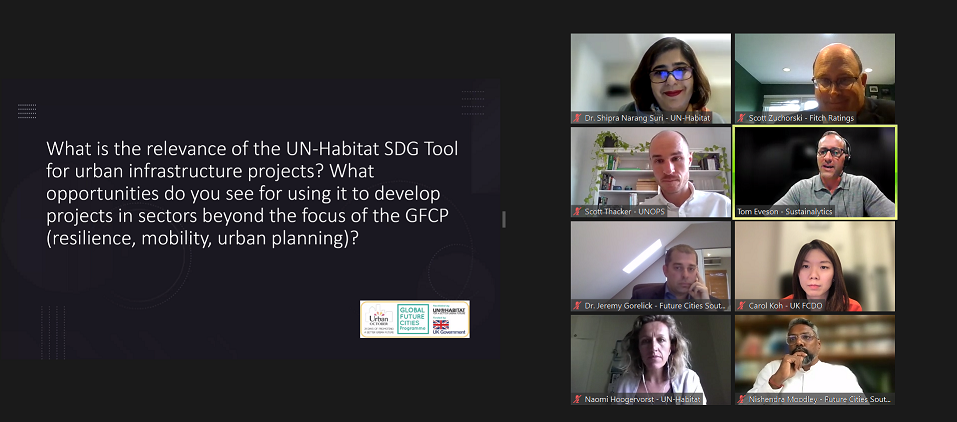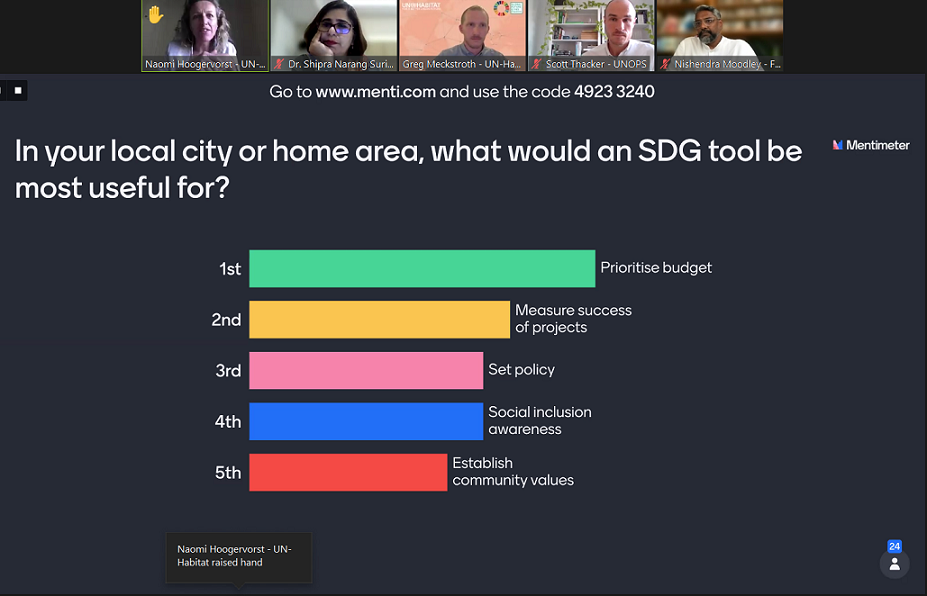Using the SDG Tool to guide sustainable development and investment decisions
The worlds of finance and sustainable urban development are converging and will continue to do so in future in the face of climate change and other threats to sustainable development. This convergence will open further financing opportunities for transformative urban development and infrastructure projects that align with the Sustainable Development Goals (SDGs), noted speakers at a recent Expert Group Meeting of the Global Future Cities Programme (GFCP).
The virtual Expert Group Meeting, ‘SDG-oriented urban project design: an opportunity for sustainable growth and investment’ took place Friday, 29 October, as a side-event at the SDG Cities Global Conference. It was open to participation from the public globally.
The SDGs are becoming an "umbrella language for all aspects of financial investments,” said panellist Tom Eveson, Founding Partner at the Emerging Markets Infrastructure Fund Group. “The innovation being applied to sustainable-themed financing is incredible and inspiring.”
The SDGs are going from a “nice to have” to a “must have,” particularly for projects that want to access private capital, he added.
UN-Habitat's SDG Project Assessment Tool guides city authorities and private-sector delivery partners in the development of more inclusive, sustainable and effective urban projects. The Global Future Cities Programme has used the tool to guide development of 30 transformative urban development projects in 19 fast-growing cities in emerging economies.
The aim of the SDG Tool is for cities to become “better clients” to the private sector. It empowers them to ask the right questions, while taking ownership of urban development projects that promote viable investment, explained UN-Habitat's Naomi Hoogervorst, Programme Manager for the GFCP.
Panellists highlighted the value of the tool for bringing stakeholders together for collective engagement to discuss the strengths and weaknesses of urban development projects, build capacity, and evaluate the bankability of projects and their long-term viability.
The SDGs are “a powerful universal language” and using them to measure impact resonates well with various parties, including cities and delivery partners, said Carol Koh, Prosperity Future Cities Programme Adviser Malaysia, UK Foreign, Commonwealth & Development Office (UKFCDO).
The process of using the SDG Tool in South Africa for the Soweto Strategic Area Framework was different to an audit or evaluation of the delivery partner, explained Nishendra Moodley, team Lead for Future Cities South Africa during his presentation. Rather, it turned out to be a “dialogue-based assessment” of the project between city officials and the delivery partner.

A tool like the SDG Tool has potential for use by credit ratings agencies, offering the ability to identify higher risk areas in cash flow and debt projections for infrastructure and development projects, and helping them understand the vulnerabilities and ways to mitigate those from an SDG perspective, said Scott Zuchorski, Managing Director and Head of North American Infrastructure at Fitch Ratings.
Additionally, the SDG Tool can steer decisions around the development of sustainable, inclusive, and resilient infrastructure that helps mitigate climate impacts.
“Infrastructure, and making sure we make the right choices about how it’s developed across its lifecycle, is absolutely key,” said Dr. Scott Thacker, Infrastructure and Project Management Specialist at the United Nations Office for Project Services.
Research finds that Infrastructure can influence 72 percent of the SDG targets. It can also contribute to 79 percent of greenhouse gas emissions and 88 percent of all adaptation costs, said Thacker.
Experts noted that cities in the developing world have constrained debt capacity. Access to capital is often restricted by the credit ratings of municipalities, while local development projects often lack financing opportunities in comparison with large national programmes. The SDG tool can unlock financing opportunities by backstopping these smaller projects through improving access to impact and Environmental, Social and Governance (ESG) financing.
As finance and development continue to converge, using “standardised language,” as the SDG Tool does, will help to inform better decisions, said Dr. Jeremy Gorelick, Senior Strategic Advisor at the Green Finance Institute.
Using the SDG Tool is a “collective exercise to get the best possible, the most catalytic, impactful and bankable investments ready for cities,” said moderator Dr. Shipra Narang Suri, Chief, Urban Practices Branch, UN-Habitat, in her closing remarks.
During the audience engagement component of the session, attendees were asked how the SDG Tool could be enhanced and made more relevant to a broader user-base. The audience suggested that it could be simplified, turned into a mobile app, and made more visible "on the street." The UK FCDO's Carol Koh noted that it could also be made more accessible to youth.

The Expert Group Meeting at the SDG Cities Global Conference followed a closed session Expert Group Meeting, which took place 28 October. At that session, representatives from the Global Future Cities Programme’s delivery partners shared their perspectives on incorporating the SDGs into urban project design.
Panellists included speakers from Ernst and Young, Arup, Mott MacDonald, Broadway Malyan, and Future Cities South Africa. They were joined by panellists from UN-Habitat, UKFCDO, and the UK Built Environment Advisory Group (UKBEAG).
Insights from the experts who took part in both Expert Group Meetings will contribute to an upcoming set of normative reports about the Global Future Cities Programme produced by UN-Habitat.
If you missed the open session, or would like a recap, the video is available via UN-Habitat’s YouTube channel.
Please reach out to us at unhabitat-globalfuturecities@un.org for follow up or/and join our community to engage into further discussions.
Partner
UN-Habitat
Themes
Climate Change
Financial Strategies
Strategy & Planning
Author(s)

Brendon Bosworth
Communications Specialist, Human Element Communications